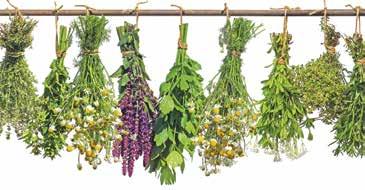
5 minute read
INDOOR EDIBLE
Indoor Edible Gardening
Grow Veggies, Sprouts and Microgreens Year-Round
by April Thompson
There’s no need to wait until the last frost date to sow a kitchen garden. Impatient gardeners or those without outdoor space can grow almost anything indoors with a little light and creativity.
“You can start many edible plants from seed on a sunny windowsill, even in late winter. You’ll be surprised how quickly everything germinates this time of year,” says Zia Allaway, the British author of Indoor Edible Garden: Creative Ways to Grow Herbs, Fruits, and Vegetables in Your Home. Herbs, tomatoes, cucumbers and peppers are among the many foods that can be easily grown from seed indoors, according to Allaway. Many fruiting plants that are not self-pollinating, such as cucumbers, need a boost from hand pollination if growing them indoors. Allaway adds, “When growing any plants on a windowsill, rotate them periodically so they grow evenly, as they will turn toward the light.”
While crops like garlic, beets and carrots won’t reach maturity indoors, they can still be grown inside for their tasty, nutritious leaves. To grow garlic shoots, for example, remove the papery outer case and submerge the flat end of a garlic bulb in a container of water, leaving the top exposed to air. Within a few weeks, garlicky-flavored shoots will sprout up that can be harvested and used like chives, advises Allaway.
To maximize space, she suggests growing plants vertically, perhaps by hanging bushy herbs or trailing plants in a window basket. She has also used interior walls to erect a trellis for vining plants like cucumbers, wiring it up with screw eyes.
Mini-Greens, Major Nutrients
Many health-conscious gardeners are drawn to sprouts and microgreens for their
PURE PASTURES

Local Farm Fresh Fare / Michigan Made Products
— Your One-Stop Shop for Healthy Meats & More! Visit PurePasturesMI.com for More Info — Weekly Specials • Free Home Delivery • Two Convenient Locations Local, Free Range, Pasture Raised, and Grass Fed Offerings, Including:
• Beef • Chicken • Buffalo • Venison
• Pork • Turkey • Lamb • Rabbit • Duck • Elk • • • • • • • Pastured, Non-GMO Eggs Great Lakes Fish Local Honey & Maple Syrup Paleo-Friendly/Gluten-Free Selections Organic, Grass-Fed Dairy Products Large Cheese Selection Beef, Chicken & Buffalo Bones for all • your Bone Broth Needs Wild-Caught Scallops & Shrimp,
Flounder & Cod, Salmon (Sockeye,
Coho & Chinook). • No Gill Nets • No Farmed Fish
nutritional benefits, as they contain as much as 40 times the nutrients as their full-grown counterparts. Sprouts can easily be grown with or without soil, and are eaten before the first tiny cotyledon leaves emerge, whereas microgreens are harvested later, often just before or after the first true leaves, the second pair, pop up.
“Sprouted greens grown at home are the freshest food you’ll ever eat. Being able to grow your own salads is also a lot of fun in the winter, to see the wonderful colors growing on your shelf,” says Peter Burke, the Calais, Vermont, author of Year-Round Indoor Salad Gardening: How to Grow Nutrient-Dense, Soil-Sprouted Greens in Less Than 10 Days.
Burke’s tried and true method is to plant a small amount of seed every day from a mix of sunflower, peas, radish, buckwheat and brassicas like broccoli or kohlrabi, providing a steady supply of his family’s daily dose of greens. While some gardeners grow sprouts or microgreens directly on paper towels or coconut coir, Burke prefers using a store-bought, germination soil mix, spread up to two inches deep in reusable trays, watered once a day and grown without artificial light.
Many seeds commonly found in the home pantry can be turned into sprouts and shoots, says Lina Wallentinson, the Swedish author of Sprouts, Shoots and Microgreens: Tiny Plants to Grow and Eat in Your Kitchen. “Mustard seeds from the spice shelf, whole lentils in all colors, chickpeas and yellow peas can all be easily grown for sprouts and shoots without any special equipment,” she says.
Seeds can be put into wide-mouthed jars, soaked overnight, and then drained and rinsed two to three times a day. Germination of seeds into sprouts, from mung beans to quinoa, can typically take less than 24 hours with this method.
Sprouts and microgreens make great toppers for salads, soups, sandwiches or smoothies, and they can also be cooked. “Newly sprouted mung and lentil seeds with a short ‘tail’ are perfect to flash-fry and season with soy, chili and a little sesame oil as an alternative to rice or pasta,” says Wallentinson. “Sprouts are also nice to bake with. Like seeds and nuts, they give a good little chew in all kind of breads.”
Whether growing sprouts, microgreens or full-sized plants, Allaway advises home gardeners to make drainage holes at the bottom of the containers to avoid overwatering. “It’s better to underwater than overwater a plant, because once it starts to rot, it’s game over. There is also research showing that a little stress from occasional underwatering can trigger the plant to produce more phytochemicals, which are nutritionally beneficial,” she says.
Connect with Washington, D.C., freelance writer April Thompson at AprilWrites.com.

Discover the Healer in You!
Better Your life and the Lives of Your Family and Friends through the Power of Herbs.

Take Your Passion to the Next Level.
Sign up for our essential class on medicinal herbs and their healing properties. Learn how to select them and make remedies based on body systems.
~ Herbs that Heal ~
There is nothing like nature’s medicine and the healing power of herbs. Become a Certified Herbalist. Learn the role of herbs as foods and medicines throughout history. In this class, you will gain a deeper understanding of the body systems and conditions that herbs affect, the most effective way to use them whether that be by teas, extracts, poultices, ointments or powdered capsules. This class is an excellent place to start for people new to herbal studies and usage or for those who want to expand their working knowledge of herbs. Wholistic Training Institute is a State of Michigan Licensed Proprietary School.

Wholistic Training Institute
20954 Grand River Ave, Detroit Call Today! (313) 255-6155 WholisticTrainingInstitute.com




